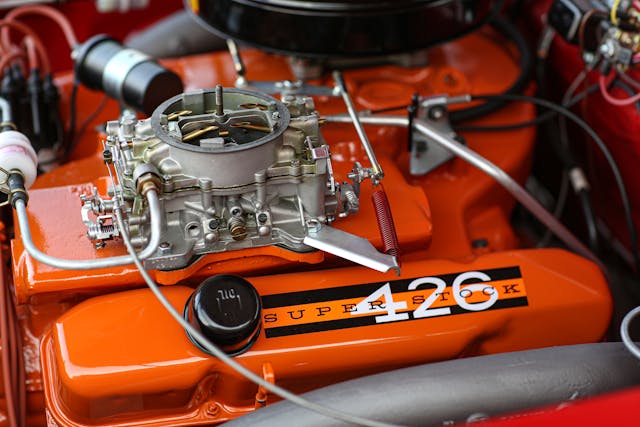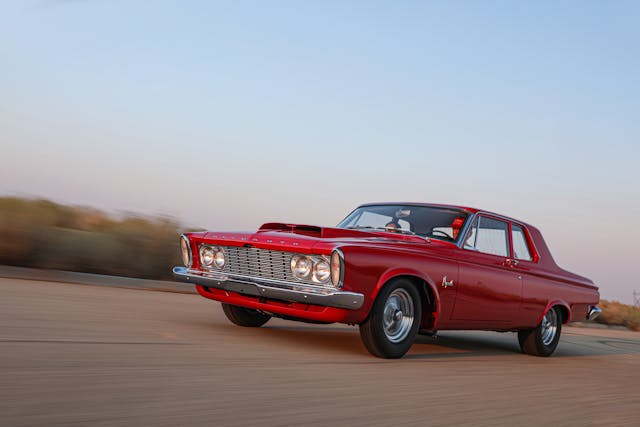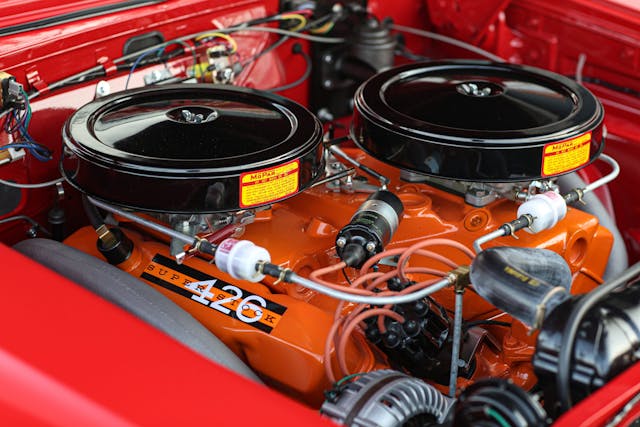On 4/26, we celebrate the other 426
Today is 4/26—a calendar date that conjures up other notable 426s in history, namely Mopar’s vaunted V-8s. On this date we’ve previously heralded the short-lived but well-respected 426 Hemi, but that wasn’t the first V-8 of such displacement to come from Chrysler Corp. Before the street Hemi bowed in 1966, and even before Richard Petty used a 426 Hemi to take the checkered flag at the 1964 Daytona 500, another 426 was top dog among Mopar racers: the Max Wedge. Often overshadowed by its big-headed younger sibling, the Wedge is worthy of praise all on its own.

There’s no denying that Hemi engines offer a lot of benefits over the more common inline-valve competitors, but they do have drawbacks. Pushrod Hemi engines require a relatively more complicated valvetrain and machining process. They’re also large and heavy, reducing some of the inherent benefits of a pushrod design. When replacing its early Dodge, DeSoto, and Chrysler Hemi engines of the 1950s, Chrysler Corporation developed a big-block V-8 architecture that used a more common wedge-shaped combustion chamber. The B family of V-8s introduced in 1958 included 350- and 361-cubic-inch displacements, both with 3.375-inch strokes. In 1959, a tall-deck variant, dubbed RB, brought the capacity for a 3.75-inch stroke, which was used in all subsequent factory RB engines. Initially offered in 383 and 413-cubic-inch displacements, the RB V-8 would provide the horsepower for a wide range of Mopar vehicles, from the sleek Chrysler 300H to the stripped-down coupes that competed on track and at the dragstrip.
Starting with the 413 in 1962, Mopar built race-only versions of the RB intended to take on 400+ cubic-inch offerings from Ford, Chevrolet, and Pontiac—the latter of which was cooking up a mean 421. With high compression ratios (11.0:1 and 13.5:1), fortified rotating assemblies, big cam lobes, gorgeous cast exhaust manifolds, a cross-ram intake, and high-flow cylinder heads, Chrysler dubbed its maximum-effort competition engine “Max Wedge”. In 1962, the 413 Max Wedge offered as much as 420 horsepower if built with the higher of the two compression ratios offered. When installed in Plymouths it was referred to as the Super Stock 413. When bolted between the frame rails of a Dodge it was known as the Ramcharger 413, in honor of the so-nicknamed drag racing engineers who had helped spearhead Mopar’s performance push.

For the 1963 season, the NHRA instituted a displacement limit of 7.0 liters for many of the factory drag racing classes, including Super Stock. Mopar was poised to take advantage. After just one year of racing, the Max Wedge 413 made way for the Max Wedge 426 that used the same 3.75-inch stroke and combined it with a 4.25-inch bore. Power in the 11:1 426 was rated at 415 horses, which was five more than in the 413. The 13.5:1 engine got a similar bump, for a total of 425 hp.
As if the huge power from these big-blocks wasn’t enough, Mopar put them in cars that featured lightweight sheet metal and bumpers. Not only did they hold their own against Super Duty Pontiacs and 427 Fords in the early and mid-’60s, but they continue to set records in vintage racing classes to this day.
If you’d like to see one in fantastic condition, be sure to read this feature story from last year on a 1963 Savoy Max Wedge that’s likely the finest of its kind. It’s worth a second look, especially on 4/26.
Check back with us tomorrow to celebrate the 427 on 4/27!



